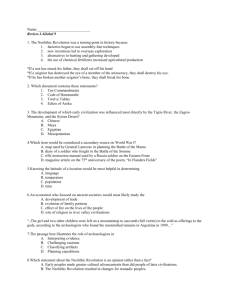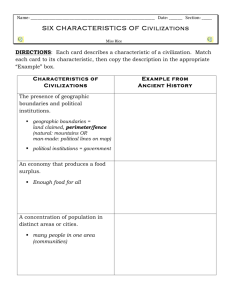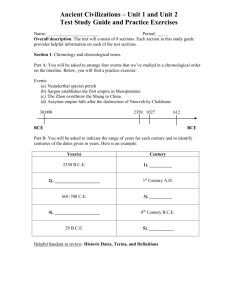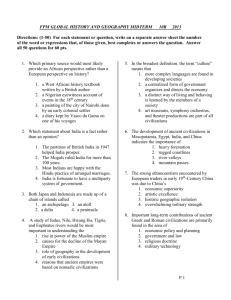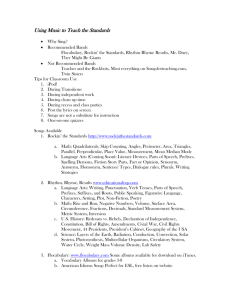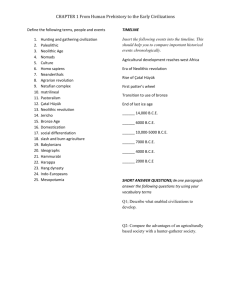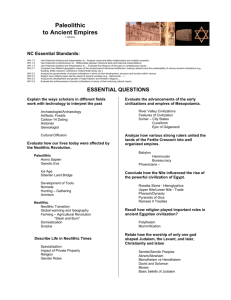Review 1 - Lyons-Global
advertisement
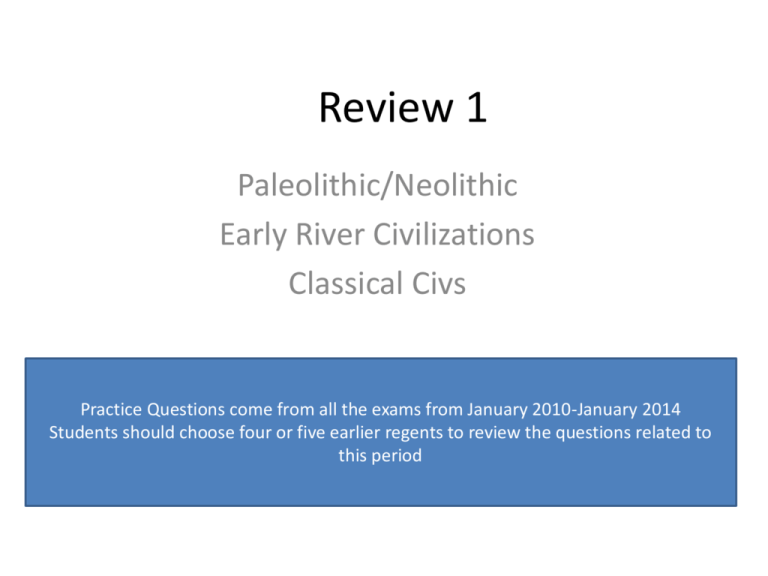
Review 1 Paleolithic/Neolithic Early River Civilizations Classical Civs Practice Questions come from all the exams from January 2010-January 2014 Students should choose four or five earlier regents to review the questions related to this period What is my job • Economist – studies scarcity of goods and natural resources and how people obtains their wants/needs (ex – traditional, manorialism, mercantalism, capitalism/market) • Archaeologist – studies the artifacts of ancient civilizations • Anthropologist – studies how man interrelates with each other and/or develops (physical, cultural, social) • Geographers– studies how man has populated the earth and adapted it for his needs June 2011 1. An economist who focused on ancient societies would most likely study the (1) development of trade (2) evolution of family patterns (3) effect of fire on the lives of the people (4) role of religion in river valley civilizations August 2010 2. An economist is a social scientist who focuses on the study of the (1) development of spiritual practices (2) establishment of legal systems (3) creation and implementation of social class systems (4) production and exchange of goods and services August 2010 • Analyzing the design of a Shang bronze pot • Deciphering the writing on the Rosetta Stone • Examining the fabric of a Japanese kimono 3. These actions are most often performed by (1) a political scientist (3) a sociologist (2) a geographer (4) an archaeologist June 2011 4. Knowing the latitude of a location would be most helpful in determining (1) language (3) population (2) temperature (4) time June 2011 …The girl and two other children were left on a mountaintop to succumb [fall victim] to the cold as offerings to the gods, according to the archaeologists who found the mummified remains in Argentina in 1999…. — “Frozen Inca Mummy Goes On Display,” National Geographic News, September 11, 2007 5. This passage best illustrates the role of archaeologists in (1) interpreting evidence (2) challenging customs (3) classifying artifacts (4) planning expeditions June 2010 6. Which document is considered a primary source? (1) encyclopedia article (2) modern textbook (3) biography (4) personal correspondence January 2010 7. Which example best represents a primary source? (1) a 20th-century novel about events leading up to the French Revolution (2) film footage taken during the liberation of Nazi concentration camps (3) an interview with an expert on the fall of the Roman Empire (4) a lecture on the impact of the African slave trade on South America Paleolithic ©2004 Wadsworth, a division of Thomson Learning, Inc. Thomson Learning™ is a trademark used herein under license. • Nomads (hunter-gatherers) followed herds (migrate) • Began in Africa – East African Rift Valley • Mary Leakey (anthropologist) discovered some of early hominid (human-like primate) remains • Migrated to Americas across Bering Strait June 2012 8. Some archaeologists believe the earliest human presence in the Americas is associated with the (1) migration of nomads across the Bering Strait (2) exploration of the Caribbean by Europeans (3) movement of tribes during the Bantu migration (4) journey of traders along the Silk Roads Neolithic • 10,000 – due to glacial retreat and wooly mammoth dying out. • Domestication of plants and animals • Permanent settlements (urbanization) along rivers for fertile soil • Increased populations • New technology – irrigation, pottery, stone farm tools, writing • New social hierarchy – priest-kings (theocracies) • Polytheistic religions • Traditional economy (bartering) August 2011 9. What is a major feature of a traditional economy? (1) nationalizing foreign-owned businesses (2) determining prices using a free market (3) establishing quotas based on five-year plans (4) bartering for goods and services August 2010 10. June 2012 • 11 June 2010 12. Which Neolithic Revolution development led to the other three? (1) complex civilizations (2) surplus of food (3) division of labor (4) domestication of plants and animals June 2011 13. Which statement about the Neolithic Revolution is an opinion rather than a fact? (1) Early peoples made greater cultural advancements than did people of later civilizations. (2) The Neolithic Revolution resulted in changes for nomadic peoples. (3) New technology was developed during the Neolithic Revolution. (4) Agricultural developments resulted in the establishment of permanent settlements. January 2012 14. The Neolithic Revolution was a turning point in history because (1) factories began to use assembly-line techniques (2) new inventions led to overseas exploration (3) alternatives to hunting and gathering developed (4) the use of chemical fertilizers increased agricultural production January 2011 15. In which economic system used by early civilizations are decisions about the distribution of goods based primarily on customs, beliefs, and habits? (1) mixed (2) free-market (3) traditional (4) command January 2011 16. The Neolithic Revolution is often considered a turning point in history because (1) city dwellers learned to control fire (2) societies became more nomadic (3) nuclear families evolved into extended families (4) permanent settlements developed in river valleys January 2011 17. The best definition of subsistence agriculture is (1) supplying crops for overseas exports (2) bartering crops for manufactured goods (3) storing surplus food in case of famine (4) producing just enough food for a family’s use January 2010 Throughout history, many changes have occurred in the way food is produced. Some of the major changes occurred during the Neolithic Revolution, Agrarian (Agricultural) Revolution, and the Green Revolution. These changes in food production had political, social, and economic effects on societies and regions. Task: Select two food production revolutions mentioned in the historical context and for each • Describe the change in food production during that revolution • Discuss political, social, and/or economic effects the change in food production had on society or a region January 2010 18. The Indus and Huang He (Yellow) rivers are both closely associated with (1) border disputes (2) sacred biblical sites (3) cradles of early civilization (4) oil discoveries August 2013 19. One way in which the ancient Sumerians, Egyptians, and Mayas are similar is that these civilizations developed (1) irrigation systems (2) iron weapons (3) wheeled vehicles (4) block printing systems August 2012 20. Which geographic feature did the earliest civilizations in Egypt, India, and China have in common? (1) mountains that provided protection from invasion (2) rivers that increased the fertility of the land by flooding (3) vast forests that supplied lumber for building (4) tropical climates that included monsoons Mesopotamia Sumerians • • • • • • • Competitive city-states Ziggurats (temples) Cuneiform writing – Epic of Gilgamesh Irrigation (rivers flood erratically) Math based on 60 Queen Puabi had human sacrifices Destroyed easily by Akkadians – no natural barriers January 2011 21. Why is Southeast Asia considered a crossroads? (1) Large deposits of oil are available. (2) A number of trade routes intersect. (3) A single culture is dominant. (4) Rivers serve as highways. January 2011 22. Which name identifies the region located between the Tigris and Euphrates rivers? (1) Cape of Good Hope (2) Sinai Peninsula (3) Mesopotamia (4) Horn of Africa August 2011 23. The development of which early civilization was influenced most directly by the Tigris River, the Zagros Mountains, and the Syrian Desert? (1) Chinese (3) Egyptian (2) Maya (4) Mesopotamian Aug 2012 24. The ancient Sumerians modified their environment to increase food production by (1) building terraces (2) removing rain forests (3) digging irrigation canals (4) developing chinampas Jan 2013 25.Which river system is found in Mesopotamia? (1) Nile River (2) Yellow River (3) Tigris and Euphrates rivers (4) Ganges and Brahmaputra rivers August 2010 26. One way in which The Epic of Gilgamesh, The Odyssey, and The Mah¯abh¯arata are similar is that they are (1) sets of written legal principles that spell out the rights of citizens (2) stories that are tied to monotheistic religious beliefs (3) paintings that depict heroes and cultural values (4) works of literature that give historians information about early civilizations June 2011 Theme: Technology Throughout history, societies have developed significant technological innovations. These technological innovations have had both positive and negative effects on a society or on humankind. Task: Select two technological innovations and for each • Discuss why the technological innovation was important during a specific time period • Discuss the positive and/or negative effects this technological innovation had on a society or on humankind You may use any technological innovation from your study of global history. Some suggestions you might wish to consider include irrigation systems, stirrup, astrolabe, printing press, f Hammurabi’s Law Code • “Eye for Eye” – retributive punishment. • Based on social classes • Provides an ethical code of behavior that can be consistently applied • Handed down from heaven – can not change “carved in stone” • “If a son has struck his father, they shall cut off his hand” strict January 2010 27. The Code of Hammurabi and Chinese legalism both rely on the idea that (1) governments must provide their people with rights (2) harsh laws are needed to control society (3) all subjects are equal under the law (4) religion and government must be brought closer together June 2013 28. One way in which Hammurabi and Justinian are similar is that they successfully (1) established public education systems (2) codified the laws of their empire (3) instituted democratic governments (4) separated church and state June 2011 29. The Code of Hammurabi and the Twelve Tables of Rome are examples of (1) written laws (2) religious rules of conduct (3) economic sanctions (4) early constitutions August 2011 • If a son has struck his father, they shall cut off his hand. • If a seignior has destroyed the eye of a member of the aristocracy, they shall destroy his eye. • If he has broken another seignior’s bone, they shall break his bone. 30. Which document contains these statements? (1) Ten Commandments (2) Code of Hammurabi (3) Edicts of Asoka (4) Twelve Tables June 2012 31. The Code of Hammurabi of Babylon and the Justinian Code of the Byzantine Empire served functions similar to the (1) Ziggurats of the Sumerians (2) Buddhist stupas (3) Maya hieroglyphics (4) Twelve Tables of the Romans January 2012 32. Which pair of leaders are associated with the region shown in dark gray on this map? (1) Zheng He and Deng Xiaoping (2) Miguel Hidalgo and Augusto Pinochet (3) Hammurabi and Saddam Hussein (4) Catherine the Great and Vladimir Putin Egyptians - Nile • Ruled by Pharaoh in dynasties – Old Kingdom (Giza pyramids), New Kingdoms (Valley of the Kings) • Afterlife is important (mummification, Book of Dead, Osiris) • Hieroglyphics (Rosetta Stone translates) • Some pharaohs to know: Khufu (Great Pyramid), Hatshepsut (woman w/beard), Akhenaten (monotheistic), Tut (unrobbed), Ramses (fought the Sea People) January 2011 33. One similarity between the Nile River valley and savanna lands in Africa is that they both (1) served as major barriers to the movement of people and goods (2) provided necessary resources for settlement (3) are located on the western side of the continent (4) had little effect on the lives of the people who lived in these regions January 2014 Historical Context: Throughout history, people have changed their environments to meet their needs. These changes have had both positive and negative effects on people, societies, and regions. Examples include the development of irrigation in ancient Egypt, the construction of chinampas by the Aztecs, and the mining of coal in Great Britain during the Industrial Revolution. Select two changes people have made to their environment mentioned in the historical context and for each • Explain why this change to their environment was needed • Discuss how this change affected people, a society, and/or a region June 2012 Theme: Human and Physical Geography Throughout history, geographic features have influenced the development of civilizations and regions. Geographic features have both promoted and limited interactions with other civilizations and regions. Task: Select two different geographic features and for each • Discuss how this geographic feature influenced the development of a specific civilization or region • Discuss how this geographic feature promoted and/or limited the interaction of this civilization or region with another civilization or region You may use any geographic feature from your study of global history and geography. Some suggestions you might wish to consider include Nile River, Atlantic Ocean, Himalayas, Sahara Desert, Great Northern Plain, location of Japan, Mediterranean Sea, Russian steppes, Brazilian rain forest, and Indian Ocean monsoons. Indus River • Mohenjo-Dara and Harappa have urban planning • Socialism/communal living with Great Bath and public granary • Supposedly defeated by Aryans Geography of India • Monsoon rains • Indus & Ganges River • Deccan Plateau June 2013 34. Which statement about the early Indus River valley civilization is an opinion rather than a fact? (1) Farmers grew a surplus of barley, wheat, and dates. (2) The Indus people developed a system of writing. (3) Planned cities indicated a use of technology. (4) The Indus city-states were the most developed of the time period. January 2012 35. The Thar Desert, Ganges River, and Deccan Plateau are all geographic features of (1) Japan (2) China (3) India (4) Indonesia August 2010 36. The term monsoons can be defined as (1) seasonal winds (2) sand deposits (3) ocean currents (4) mountain avalanches Classical India • Hinduism – caste system (karma, dharma, reincarnation), polytheistic • Mauryan Empire – Hindu until Asoka converts to Buddhism (establishes rest stops, laws, period of peace) June 2010 37. In the traditional Hindu caste system and in the social hierarchy of colonial Latin America, the status of a person was usually determined by (1) education (3) birth (2) wealth (4) power August 2012 38. Believers of Hinduism are expected to (1) fulfill their dharma for a favorable reincarnation (2) complete a pilgrimage to Mecca (3) obey the Ten Commandments (4) follow the Eightfold Path to achieve enlightenment January 2012 39. Which concept is most closely associated with this map of Asia? (1) nonalignment (3) colonization (2) urbanization (4) cultural diffusion August 2011 40. Which religion includes the Four Noble Truths, the Eightfold Path, and nirvana? (1) Buddhism (3) Judaism (2) Hinduism (4) Christianity Classical India (cont) • Gupta – “Golden Age” – Restores Hinduism – Math and science achievements (pi, zero, decimals, Arabic numbers) – Promoted art and literature June 2013 41. Which geographic feature would have most likely hindered the expansion of the Guptas into what is modern-day China? • (1) Thar Desert (3) Himalaya Mountains • (2) Deccan Plateau (4) Bay of Bengal Jan 2013 41. Which body of water is located between Southwest Asia and Southeast Asia? (1) Pacific Ocean (2) Caribbean Sea (3) Indian Ocean (4) Black Sea Jan 2013 Creation of colorful murals in the Ajanta caves •Development of decimal system and concept of zero Trade with Persia and east African cities 42. These accomplishments occurred during the (1) Han dynasty (3) Tang dynasty (2) Gupta Empire (4) Maurya Empire August 2012 43. Which civilization best completes the title of this outline? (1) Ghana (3) Song (2) Khmer (4) Gupta June 2011 44. The concept of zero, the expansion of the caste system, and the creation of the decimal system are most closely associated with the (1) Inca Empire (2) Tokugawa shogunate (3) Song dynasty (4) Gupta Empire June 2012 45. One way in which the ancient city-state of Athens and the Gupta Empire are similar is that both (1) allowed universal suffrage (2) developed matriarchal societies (3) promoted art and literature (4) established plantation agriculture August 2011 46.Which geographic factor affected the development of the Gupta Empire? (1) volcanoes (2) permafrost (3) monsoons (4) island location August 201 • Preserved Hindu traditions • Produced fine poems and drama • Made advances in mathematics, science, and Medicine 47. These achievements refer to contributions of the (1) Gupta Empire (3) Greek city-states (2) Persian Empire (4) Tang dynasty Classical China • Ethnocentric - belief your culture is superior (because of geographic isolation) • Mandate of Heaven • Oracle Bones – ancestors important • Confucianism (5 Relationships, filial piety, Analects), Legalism, and Daoism emerge in 500s • Shi Huangdi (Qin) – centralized government, legalism, uniformity of writing, Great Wall, terracotta warriors August 2011 50. Which geographic feature has helped isolate China? (1) Andes Mountains (2) Kalahari Desert (3) Himalaya Mountains (4) Great Rift Valley August 2010 51. Which geographic feature served as a barrier that protected ancient China and was used as an invasion route by the Aryans into ancient India? (1) deserts (3) mountains (2) rivers (4) plateaus August 2010 52. Which statement about China is a fact rather than an opinion? (1) Flooding was the worst disaster to affect ancient Chinese civilizations. (2) The Mandate of Heaven was an idea developed in ancient China. (3) Early Chinese civilizations were the most important civilizations in the world. (4) Dynastic governments were highly effective in China. January 2010 53. The Code of Hammurabi and Chinese legalism both rely on the idea that (1) governments must provide their people with rights (2) harsh laws are needed to control society (3) all subjects are equal under the law (4) religion and government must be brought closer together August 2011 54. The rule of Shi Huangdi, legalism, and the tomb of terra cotta soldiers are most closely associated with the (1) Maurya Empire (3) Persian Empire (2) Qin dynasty (4) Hellenistic culture June 2011 55. Which Chinese philosophy best completes this graphic organizer? • (1) Maoism (3) legalism • (2) Daoism (4) Confucianism January 2011 56. Filial piety and the five relationships are most often associated with (1) Hinduism (2) Daoism (3) animism (4) Confucianism January 2013 57. Oracle bones, Daoism, and the Mandate of Heaven are all associated with early civilizations in (1) Egypt (3) India (2) Russia (4) China January 2012 58. These photographs indicate the people of China and the people of ancient Peru modified their environment to (1) create effective trade routes (2) increase the amount of land available for agriculture (3) move large quantities of water into cities (4) provide an effective defense August 2011 59. Use of terracing is an example of a society’s reaction to (1) religious beliefs (2) social stratification (3) geographic conditions (4) political situations June 2012 60. What is one way in which animism, Shinto, and Daoism are similar? (1) emphasis on harmony with nature (2) monotheistic belief systems (3) belief in the idea of nirvana (4) reliance on the teachings of the Vedas June 2013 61. The Great Wall of China and the Berlin Wall were both intended to (1) halt the spread of communism (2) isolate unpopular governments (3) limit the movement of peoples (4) keep people from smuggling illegal goods June 2012 Historical Context: Throughout history, autocratic leaders have exercised authority over their countries and the lives of their people. The actions of autocratic leaders have both helped and hurt their countries and their peoples. Examples of such leaders include Emperor Shi Huangdi, Czar Peter the Great, and King Louis XIV. Select two leaders mentioned in the historical context and for each • Describe actions taken by the leader that show this individual was an autocrat • Discuss the extent to which this leader’s use of autocratic power helped and/or hurt his country or his people Classical China - continued • Han (200 BC – 200 AD) – Silk Road established (golden age of trade) – Paper and Silk – Emperor Wudi has bureaucracy with civil service test on Confucianism – Collapse due to invasion, Buddhism entering, peasant revolt January 2014 61. Which belief system was the basis for the civil service exams given during the Han, Tang, and Song dynasties? (1) legalism (3) Buddhism (2) Daoism (4) Confucianism January 2012 62. Which philosophy is most closely associated with the development of the Chinese civil service system? (1) legalism (3) Daoism (2) Buddhism (4) Confucianism August 2013 63. Trade along the Silk Roads and the transSaharan trade routes resulted in (1) elimination of all traditional beliefs (2) a movement toward decolonization (3) the Columbian exchange (4) cultural diffusion between different societies Southwest Asian Empires • Assyrian – capital at Nineveh, forced Jews to relocate “Babylonian Captivity” – located in earlier “Fertile Crescent” • Persians – 4 capitals, road system, satraps to govern provinces, pony express June 2012 64. Based on the information shown on this map, in which region was the Middle Kingdom of Assyria located? (1) southwest Asia (2) western Africa (3) South America (4) western Europe 65. The Middle Kingdom of Assyria was located in an area also known as the (1) subcontinent (2) Holy Land (3) Fertile Crescent (4) rooftop of the world Geography of Greece • Lots of natural harbors – good for trade and creating oversea colonies • Lots of mountains – divides Greece into independent citystates • Lacked good farmland and rivers January 2011 66. Which geographic feature most directly influenced the development of Greek citystates? (1) deserts (3) vast plains (2) mountainous terrain (4) monsoons Classical Greece • Polis (city-states) – Athens (democracy, reformers like Cleisthenes w/ostracism and Pericles) known for philosophers like Socrates and promoted art and temples like Parthenon on Acropolis – Sparta (military state – oligarchy with helot slaves) • Major Wars (Persian War – Battles of Marathon and Salamis w/triremes and Peloponnesian War – plague interrupts) • Culture – Olympic games, Zeus et al., doric/corinthian/ionian columns, theaters – drama like Sophocles Jan 2014 67. What was one of the most important contributions of the Greek city-state of Athens? (1) development of direct democracy (2) diffusion of a monotheistic belief system (3) promotion of the equality of all humans (4) creation of a writing system using hieroglyphics August 2013 68. Which geographic factor contributed to the formation of independent city-states in ancient Greece? (1) tropical rainforests (2) fertile farmland (3) navigable rivers (4) mountainous topography August 2013 …We give our obedience to those whom we put in positions of authority, and we obey the laws themselves, especially those which are for the protection of the oppressed, and those unwritten laws which it is an acknowledged shame to break.… — Pericles, quoted in History of the Peloponnesian War 69. In this quotation, Pericles is praising Athenian (1) civic values (2) artistic creativity (3) military strengths (4) commercial success Jan 2012 70. Which statement about ancient Greece is an opinion rather than a fact? (1) Mountainous terrain was an obstacle to Greek political unity. (2) The Spartan culture placed an emphasis on military skills. (3) Athens granted voting rights to male citizens only. (4) Greek architecture was superior to Persian architecture. January 2012 Theme: Change—Individuals Throughout history, various circumstances have led individuals to develop or modify ideas. These ideas have often affected societies. Task: Select two individuals from your study of global history and for each • Describe the historical circumstances that led this individual to develop or modify an idea • Explain an action taken by this individual as a result of this idea • Discuss how this individual’s idea affected a society You may use any individual from your study of global history and geography. Some suggestions you might wish to consider include Pericles, Martin Luther, Queen Elizabeth I, August 2013 Theme: Conflict—Armed Conflict Task: Select two armed conflicts and for each • Describe the historical circumstances leading to this armed conflict • Discuss the ways in which this armed conflict affected a specific group of people, a country, and/or a region You may use any examples of armed conflict from your study of global history and geography. Some suggestions you might wish to consider include the Peloponnessian War Hellenistic Greece • Alexander the Great created by taking over Greece and Persia • Cultural diffusion with many scientific /mathematical achievements – Hippocratic Oath, Pythagorean Theorem • Realism replaces heroic idealism • Did not have a successor so civil war June 2010 71. One way in which the actions of Alexander the Great, Saladin, and Shaka Zulu are similar is that each implemented (1) military strategies to defeat opponents (2) constitutions to define political powers (3) policies to increase religious persecution (4) legal changes to protect human rights Classical Romans • Republic – Senate (patricians led by 2 consuls) and tribunes (plebeians), Julius Caesar (1st triumvirate then dictator for life), slave revolt (gladiator – Spartacus) • Law of 12 Tables – “innocent until proven guilty” • Augustus – 1st Emperor “Pax Romana” – golden age, expanded by legion (built aqueducts, roads, forts, walls), Coliseum and Pantheon, Vergil poetry, Pompeii & Herculaneum January 2010 72. A geographic similarity between Italy and India is that both of these countries are located (1) on peninsulas (2) on archipelagos (3) between two oceans (4) south of the equator August 2013 73. At the height of its power, which ancient civilization controlled the entire coastal region surrounding the Mediterranean Sea? (1) Phoenician (3) Roman (2) Persian (4) Carthaginian June 2010 • Romans destroy the temple in Jerusalem. • British officials partition India. • Hutus and Tutsis fight in Rwandan civil war. 74. One way in which these events are similar is that each resulted in the (1) establishment of uniform legal codes (2) emigration of people from their homelands (3) intervention of coalition military forces (4) acceptance of new political boundaries Collapse of Romans • Trajan expands too far (Hadrian builds walls) • Diocletian divides creates tetrarchy • Constantine reunites – uses Christianity to do so (Edict of Milan) • Latifundia (large farms) uses too much slave labor – poor independent farmers out of work Collapse of Romans (cont) • Hire German mercenaries • Debasement of Coins • Political upheavals – legions loyal to military leader not emperor, Commodus thought he was Hercules • Invasions by Huns, Visigoths, Vandals, etc. June 2013 75. What was one reason for the decline of both the Han dynasty and the western Roman Empire? (1) outbreak of war between religious groups (2) inability to force back foreign invaders (3) efforts of the middle class to gain power (4) lack of a common currency August 2012 76. Which factor contributed to the fall of the Han dynasty, the fall of the Roman Empire, and the fall of the Abbasid Empire? (1) invasions by nomadic peoples from Central Asia (2) demands for religious freedom by Christians (3) long periods of drought that led to isolation (4) dependence on slaves to produce manufactured goods Theme: Change—Collapse of Government January 2013 The sudden death of a ruler, a defeat in war, or a successful revolution has often led to the collapse of a government. Political, social, and economic changes have occurred as a result of the collapse of a government. Task: Select two situations where the collapse of a government has led to significant changes in a country or region and for each • Describe the historical circumstances that led to the collapse of a government • Discuss the political, social, and/or economic changes that occurred as a result of the collapse You may use any situation from your study of global history and geography in which the collapse of a government led to significant changes in a country or region. Some suggestions you might wish to consider include collapse of the Roman Empire, collapse of Louis XVI’s government, August 2012 Theme: Technology Throughout history, existing technology has been modified or replaced by new technological innovations. These new technological innovations have had various effects on societies and the world. Task: Select two technological innovations and for each • Describe the existing technology that was replaced by this new technological innovation and how this new innovation changed the existing technology • Discuss the effects this new technological innovation has had on a society or the world You may use any technological innovation from your study of global history and geography. Some suggestions you might wish to consider include aqueducts, gunpowder, printing press, caravel,
